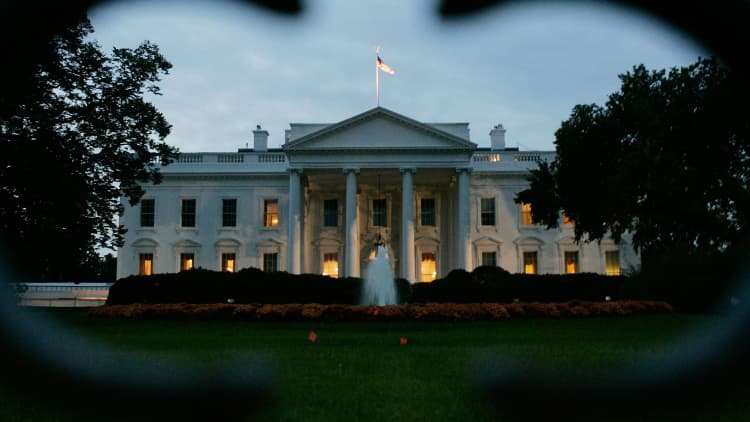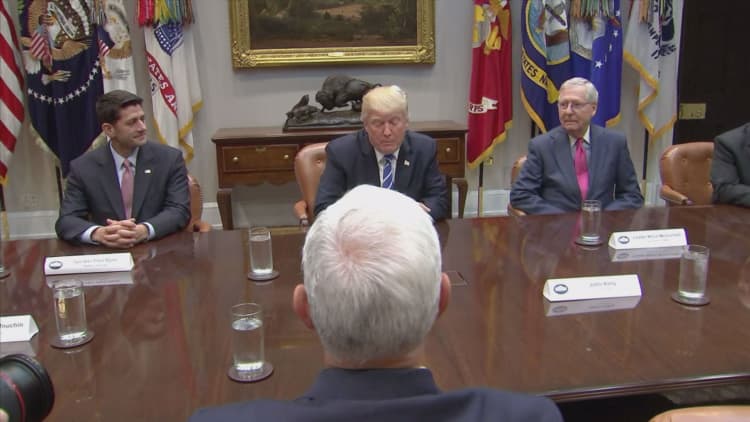
Republicans unveiled sweeping changes to America's tax code Wednesday in a proposal that dramatically lowers taxes on businesses and many households but remains silent on thorny issues such as how to pay for it all.
The framework, a joint product of the Trump administration and Republican leadership, calls for lowering the corporate rate from 35 to 20 percent. It would also bring down the rate for so-called pass-through businesses to 25 percent; currently, they are taxed under the individual code.
The plan would collapse the current seven personal tax brackets to just three: 12, 25 and 35 percent and nearly doubles the standard deduction. The child tax credit also would be substantially increased, though it is unclear by exactly how much.
Those broad brushstrokes were hashed out during months of negotiations between Treasury Secretary Steven Mnuchin, National Economic Director Gary Cohn and top Republicans in the House and Senate, a group that has come to be known as the "Big Six." Tax reform has become the clarion call for the party amid rising frustration among conservatives over the failure of the repeal and replace of Obamacare.
"Tax reform is the most important thing we can do to restore confidence to this country, to get jobs and prosperity and that's why we are so singularly focused on getting this done this year," House Speaker Paul Ryan, a Big Six member, said Tuesday.

Despite the unity around the framework, which was posted online Wednesday, Republicans still face plenty of roadblocks on the road to reform. Chief among them is that the plan does not provide much detail on how to pay for a plan that analysts have estimated could cost trillions of dollars.
"This framework is focused on supporting American jobs, on making taxes fairer and on growing families' paychecks," Senate Majority Leader Mitch McConnell said in a statement.
On the corporate side, tax credits for research and development and low-income housing are off the table. The framework also dials back House Republicans' push for full and immediate expensing to five years. The plan calls an end to the deduction for domestic production, which has been important to manufacturers, and limits on companies' ability to deduct the cost of borrowing money. No specifics are outlined in the plan, however.
The absence of details is deliberate, according to sources familiar with the negotiations, and intended to allow congressional tax writing committees some flexibility when they craft legislation later this year.
Even absent details, the plan already faces sharp criticism from Democrats and skepticism from tax experts, who argue that the proposal primarily benefits large corporations and wealthy households — which could leave President Donald Trump's populist base feeling that the president is breaking his pledge to make tax reform benefit the middle class.
"The idea that this plan would help average Americans instead of the wealthy and big corporations has been a hoax all along," said Frank Clemente, executive director of Americans for Tax Fairness. "This isn't 'tax reform,' it's just a big giveaway to millionaires and corporations, and it won't 'trickle down' to the rest of us."

The plan cuts the top individual income tax rate from 39.6 to 35 percent, but includes a possible higher fourth rate "to ensure that the reformed tax code is at least as progressive as the existing tax code."
In addition, the framework raises the bottom tax rate from 10 to 12 percent, which primarily affects for low-income households. Doubling the standard deduction and expanding the child tax credit could offset that increase for poor households — and possibly result in more people paying no taxes at all. There is also a $500 credit for anyone taking care of a family member, no matter the age.
But the plan does not detail income brackets for the new tax rates, leaving that question instead to the tax-writing committees on Capitol Hill. Depending on what they decide, some low-income households — particularly single parents — could wind up paying more, analysts said.
"They can't achieve that promise and create a structure like this," said Howard Gleckman, a senior fellow at the Tax Policy Center.
Read the entire framework document below.

